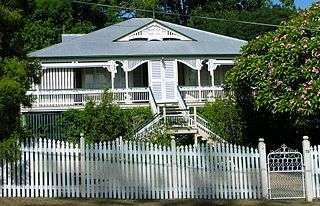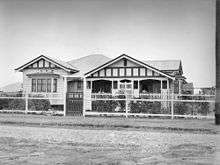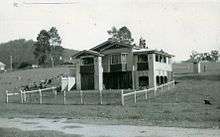Queenslander (architecture)
Queenslander architecture is a modern term for the typical residential style of Queensland, Australia.[1] It is also found in the northern parts of the adjacent state of New South Wales, and shares many traits with architecture in other states of Australia, but is distinct and unique. The form of the typical Queenslander-style residence distinguishes Brisbane's suburbs from other capital cities.


This style developed in the 1840s and is still constructed today, displaying an evolution of local style. The term is primarily applied to residential construction, although some commercial and other types of construction are identified as Queenslander.
Characteristics
The quintessential Queenslander is a single detached house made of timber with a corrugated iron roof located on a separate block of land.[1] They are all high-set, single-storey dwellings with a characteristic veranda that extends around the house to varying extents but never entirely surrounds it. In later years, many have been renovated to enclose part or all of these verandas to create extra bedrooms. The under-house area is often also enclosed to provide extra living area to these houses, which leads to the common misconception that an authentic Queenslander has two storeys.
The term has evolved to apply to many different types of structures found in suburban Queensland. The many and varied styles all share similar features such as prominent exterior staircases, gabled roofs, and the defining trait of being built on stumps, raising the structure from the traditional 2.8 m and varying in height depending on terrain.
They are typically "tripartite" in sectional composition: underfloor (stumps), primary rooms (can be two levels), and roof. All have one or more veranda spaces, a sheltered edge of the building that is typically only partly enclosed and used as another living zone. This consideration for climate is the defining characteristic of the Queenslander type.
The raising of the main living spaces off the ground can be seen as both a stylistic and practical device. The vertical "stumps", initially of timber, allow the building to "float" above the terrain. Queenslanders all have this underfloor area that is used to cool the building through ventilation and also for protection of the main structure from termite attack and other pests. The stumps also help to overcome any variations in the terrain that would normally require earthworks to flatten for construction and allow for the natural flow of water across the terrain in the event of excessive rain and downpours.[2] The underfloor space is often high enough for additional uses such as storage, a carport, or even as extra living area in the cool, dark spaces beneath the building. The underfloor area was sometimes decoratively screened at the perimeter with timber battens. Another advantage of being constructed on stumps is that the buildings are highly adaptive. Raising, lowering, reorienting, or completely relocating Queenslanders is relatively easy.[3]
The main living areas of the house, being raised from the terrain, are a series of rooms on a platform floor. Traditionally, planning and fenestration encouraged cross-ventilation for passive cooling in a variety of innovative methods, including fanlights, ceiling roses, and alignment of doors and windows to allow uninterrupted air flow. The veranda is the most typical inclusion in the plan, and can be used day and night as a semiexternal living space. In Brisbane, many people have tables and chairs for dining and a daybed or sleepout on their verandas.[4] Whirly birds placed on roofs allow for hot air to be drawn out of ceiling spaces.[5]
The roof is a large and visible presence externally, and was traditionally steeply pitched. They are of varied materials, including slate and tiles, but are most characteristically sheeted with corrugated steel. The steel roofs could withstand torrential rains and be reused if damaged by cyclonic winds.[5]
Typically, the Queenslander is suited to the subtropical climate of Queensland of high rainfall and mild to hot, humid climate with average summer temperatures in the range of 23–36°C (73–97°F). However, the type is found across the state in colder and hotter locations usually with adaptations to suit.
History
Owing to their simplicity of construction, standardised designs were produced through the 1920s and 1930s. Despite these advantages, tastes changed and the style fell out of favour after the Second World War. The need for cheaper homes first had large verandas reduced to small landings. Subsequently, internal walls were no longer made of timber and were made of fibreboards, such as asbestos sheeting or fibre/gypsum panels. Additionally, after the war, surplus military earthmoving equipment became common and preparing sites for construction was then possible and the relative cheapness of construction on stumps diminished.[6] Land availability decreased and preferences moved towards lower-maintenance types of housing.[6] These factors led to the adoption in Queensland, as elsewhere, of the ubiquitous "modern" American style, usually a single level and usually sold as a combined land and home package. These newer homes are usually made with a timber or metal frame, but with a brick veneer.
Style
The Queenslander, a "type" not a "style", is defined primarily by architectural characteristics of climate-consideration. They have been constructed in the popular styles of the time, including Colonial, Victorian, Federation, Arts and Crafts/Art Nouveau, Interwar styles, and post-World War II styles. The Queenslander is popularly thought of as an "old" house, although Queenslanders are constructed today using modern styles, as well as "reproductions" of previous styles.
Ashgrovian

Ashgrovian is the term coined for a variation of the Queenslander built between the late 1920s and World War II in the suburb of Ashgrove in Brisbane. The term Ashgrovian was coined from the prolific number of these dwellings constructed in the interwar period and was an adaptation of the Bungalow style which was popular in the early parts of the 20th century. Extremely popular with middle-income earners, these dwellings were almost always fronted with a grand gable roof, often surrounded by secondary smaller gables behind. The smaller gables usually sheltered verandas and sleepouts. A staircase almost always dominated the front yard leading to the veranda, which in later years was commonly filled in to form extra rooms. Other late additions included projecting bay or box=seat windows usually centrally located in the front of the house.[7]
Current
Many old Queenslander buildings, both residential and commercial, have been demolished to make way for more modern buildings, particularly in the inner urban area of Brisbane, contributing to Brisbane's gentrification.[8] However, community awareness of urban heritage has had local governments implement conservation measures to protect the unique 'tin and timber' character of neighbourhoods and towns dominated by Queenslander architecture. While master-planned housing estates are indistinguishable from those in other states, many custom-built homes are designed in a more modern version of the Queenslander style, particularly holiday houses in coastal areas. Many Queenslander-style homes are being removed/relocated to save them from demolition when the land is being developed.
Highrise
Some elements of Queenslander house architecture can be found in some highrise buildings. Early highrise buildings had narrow balconies that were mostly used for cleaning the outside of windows. In Queensland, highrise balconies gradually evolved to become wide outdoor living spaces of the quality of verandas and the back decks of Queenslander houses.
See also
- Architecture of Australia
- Bahay na Bato, an architectural style that evolved for the tropics in the Philippines
References
- Osborne, Lindy. "Sublime design: the Queenslander". Architecture & Design. Archived from the original on 24 February 2018. Retrieved 24 February 2018.
- History of The Queenslander Archived 24 February 2011 at the Wayback Machine. Retrieved on 1 October 2012.
- "Conservation of Queenslander houses". Queensland Museum. Archived from the original on 8 October 2012. Retrieved 1 October 2012.
- Rickertt, Jeff (2014). "Brisbane Between the Wars" (PDF). Fryer Folios. 9 (1): 22. Archived (PDF) from the original on 3 March 2016. Retrieved 4 December 2014.
- Gregory, Helen; Dianne Mclay (2010). Building Brisbane's History: Structure, Sculptures, Stories and Secrets. Warriewood, New South Wales: Woodslane Press. pp. 94–95. ISBN 9781921606199.
- "Achieving a Fusion of Past and Present – Bringing the best of Queensland Architecture into the 21st Century". dion seminara architecture. Archived from the original on 27 April 2012. Retrieved 1 October 2012.
- "Housing style – interwar years (Royal Australian Institute of Architects)" (PDF). Archived from the original (PDF) on 4 October 2006. Retrieved 10 May 2007.
- Molina, Liliana (19 March 2016). "Brisbane real estate: Can Queenslanders be preserved or will progress kill them off forever?". The Courier Mail. Retrieved 24 March 2017.
External links
| Wikimedia Commons has media related to Queenslander (architecture). |